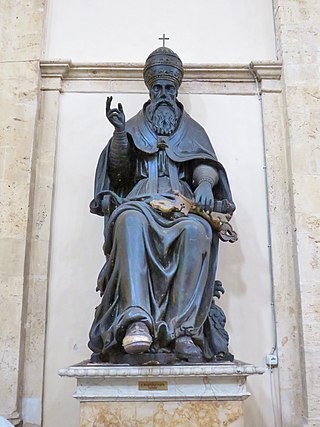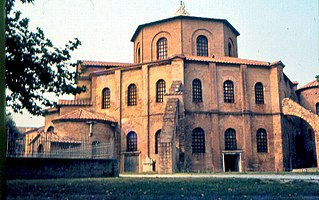
Pope Agatho served as the bishop of Rome from 27 June 678 until his death. He heard the appeal of Wilfrid of York, who had been displaced from his see by the division of the archdiocese ordered by Theodore of Canterbury. During Agatho's tenure, the Sixth Ecumenical Council was convened to deal with monothelitism. He is venerated as a saint by both the Catholic and Eastern Orthodox churches.

Pope Martin I, also known as Martin the Confessor, was the bishop of Rome from 21 July 649 to his death 16 September 655. He served as Pope Theodore I's ambassador to Constantinople and was elected to succeed him as Pope. He was the only pope during the Eastern Roman domination of the papacy whose election was not approved by an imperial mandate from Constantinople. For his strong opposition to Monothelitism, Pope Martin I was arrested by Emperor Constans II, carried off to Constantinople, and ultimately banished to Cherson. He is considered a saint by both the Catholic Church and the Eastern Orthodox Church and he is the last pope recognized as a martyr.
Pope Sergius II was the bishop of Rome and ruler of the Papal States from January 844 to his death in 847. Sergius II's pontificate saw the Arab raid against Rome as well as the city's redevelopment.
Pope Eugene I was the bishop of Rome from 10 August 654 to his death. He was chosen to become Pope after the deposition and banishment of Martin I by Emperor Constans II over the dispute about Monothelitism.
Pope Leo II was the bishop of Rome from 17 August 682 to his death. He is one of the popes of the Byzantine Papacy. Described by a contemporary biographer as both just and learned, he is commemorated as a saint in the Roman Martyrology on 28 June.

The Third Council of Constantinople, counted as the Sixth Ecumenical Council by the Eastern Orthodox and Catholic Churches, as well as by certain other Western Churches, met in 680–681 and condemned monoenergism and monothelitism as heretical and defined Jesus Christ as having two energies and two wills.
Monothelitism, or monotheletism, is a theological doctrine in Christianity, that holds Christ as having only one will. The doctrine is thus contrary to dyothelitism, a Christological doctrine that holds Christ as having two wills. Historically, monothelitism was closely related to monoenergism, a theological doctrine that holds Jesus Christ as having only one energy. Both doctrines were at the center of Christological disputes during the 7th century.
Pope Severinus was the bishop of Rome elected in October 638. He was caught up in a power struggle with Emperor Heraclius, who pressured him to accept Monothelitism. Severinus refused, which for over eighteen months hindered his efforts to obtain imperial recognition of his election. His pontificate was finally sanctioned on 28 May 640, but he died two months later.
Pope Constantine was the bishop of Rome from 25 March 708 to his death. One of the last popes of the Byzantine Papacy, the defining moment of his pontificate was his 710/711 visit to Constantinople, where he compromised with Justinian II on the Trullan canons of the Quinisext Council. The city's next papal visit occurred in 1967.
Pope Vitalian was the bishop of Rome from 30 July 657 to his death. His pontificate was marked by the dispute between the papacy and the imperial government in Constantinople over Monothelitism, which Rome condemned. Vitalian tried to resolve the dispute and had a conciliatory relationship with Emperor Constans II, who visited him in Rome and gave him gifts. Vitalian's pontificate also saw the secession of the Archbishopric of Ravenna from the papal authority.
Pope John XIX, born Romanus, was the bishop of Rome and ruler of the Papal States from 1024 to his death. He belonged to the family of the powerful counts of Tusculum, succeeding his brother, Benedict VIII. Papal relations with the Patriarchate of Constantinople soured during John XIX's pontificate. He was a supporter of Emperor Conrad II and patron of the musician Guido of Arezzo.
Pope John IV was the bishop of Rome from 24 December 640 to his death. His election followed a four-month vacancy. He wrote to the clergy of Ireland and Scotland to tell them of the mistakes they were making with regard to the time of keeping Easter and condemned Monothelitism as heresy. According to sacred tradition, he created the Catholic Church in Croatia with Abbot Martin.

Constans II, nicknamed "the Bearded", was the Byzantine emperor from 641 to 668. Constans was the last attested emperor to serve as consul, in 642, although the office continued to exist until the reign of Leo VI the Wise. His religious policy saw him steering a middle line in disputes between the Orthodoxy and Monothelitism by refusing to persecute either and prohibited discussion of the natures of Jesus Christ under the Type of Constans in 648. His reign coincided with Muslim invasions under, Umar, Uthman, and Mu'awiya I in the late 640s to 660s. Constans was the first emperor to visit Rome since the fall of the Western Roman Empire in 476, and the last one to visit Rome while it was still held by the Empire.
Pope Adeodatus II, sometimes called Deodatus, was the bishop of Rome from 672 to his death. He devoted much of his papacy to improving churches and fighting monothelitism.
Pyrrhus was the ecumenical patriarch of Constantinople from 20 December 638 to 29 September 641, and again from 9 January to 1 June 654.
Paul II was the Ecumenical Patriarch of Constantinople from 1 October 641 to his death. He assumed regency for Byzantine emperor Constans II after a succession crisis in 641. Stephanos of Clypea appears to have served as secretary/scribe of Patriarch Paulus II of Constantinople against the Monothelites, in 646 AD. He was succeeded by Peter of Constantinople.
The Ecthesis is a letter published in 638 CE by the Byzantine emperor Heraclius which defined monotheletism as the official imperial form of Christianity.

The Byzantine Papacy was a period of Byzantine domination of the Roman papacy from 537 to 752, when popes required the approval of the Byzantine Emperor for episcopal consecration, and many popes were chosen from the apocrisiarii or the inhabitants of Byzantine-ruled Greece, Syria, or Sicily. Justinian I reconquered the Italian peninsula in the Gothic War (535–554) and appointed the next three popes, a practice that would be continued by his successors and later be delegated to the Exarchate of Ravenna.

The Lateran Council of 649 was a synod held in the Basilica of St. John Lateran to condemn Monothelitism, a Christology espoused by many Eastern Christians. The Council did not achieve ecumenical status in either East or West, but represented the first attempt of a pope to convene an ecumenical council independent of the Roman emperor.
The Typos of Constans was an edict issued by eastern Roman emperor Constans II in 648 in an attempt to defuse the confusion and arguments over the Christological doctrine of Monotheletism. For over two centuries, there had been a bitter debate regarding the nature of Christ: the orthodox Chalcedonian position defined Christ as having two natures in one person, whereas Miaphysite opponents contended that Jesus Christ possessed but a single nature. At the time, the Byzantine Empire had been at near constant war for fifty years and had lost large territories. It was under great pressure to establish domestic unity. This was hampered by the large number of Byzantines who rejected the Council of Chalcedon in favour of Monophysitism.






